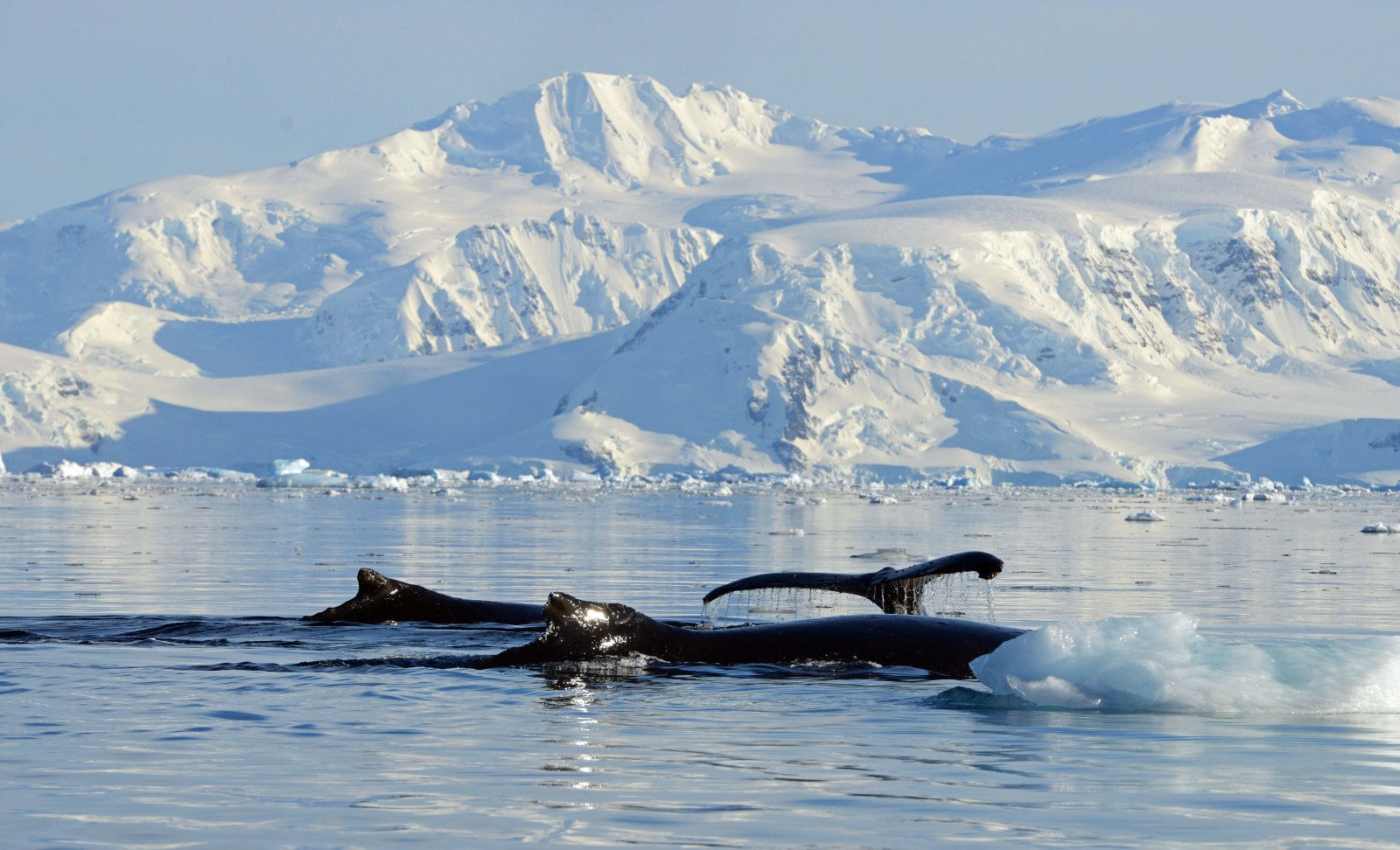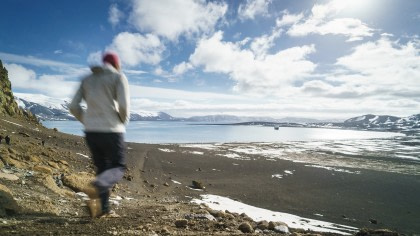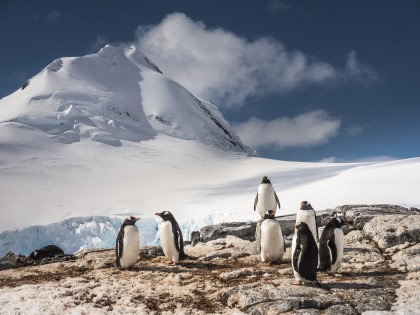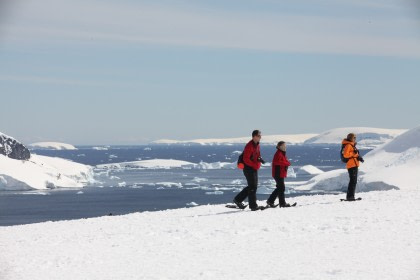The rich ecosystem of the West Antarctic Peninsula
The marine ecosystem of the West Antarctic Peninsula (WAP) extends from the Bellingshausen Sea to the northern tip of the peninsula. The WAP includes the Antarctic Sea Ice Zone, a very productive system that supports large stocks of marine mammals, birds, and Antarctic krill. One of the stars of this region, which you can see on your whale-spotting Antarctica cruise, is the humpback.

Identifying humpback whales: the hump helps
Humpback whales are easy to spot with their small dorsal fin, distinct hump at the front, long flippers, and unique black-and-white pattern on their tail. They usually travel alone or in small pods consisting of two or three whales. It is common for mothers to touch the fins of their young, which is thought to be a sign of endearment.

The singing of humpback whales
Humpbacks are famous for their beautiful, complex songs. These songs, which are made up of sequences of moans, howls, and cries, can continue for hours. However, it is only the males that sing. Scientists believe these songs could be used to attract potential mates. Males can sing for hours and repeat their song several times. In fact, all males in a population sing the same song, though the song of each population is different.
Also, the songs evolve throughout the year, so they are never caught singing the same tune for too long. Humpback whale songs travel for long distances in the ocean, capable of being heard 30 km (20 miles) away. Researchers have found that humpback whales typically make sounds with an audio frequency between 80 and 4,000 hertz.
Humpback calves guzzling milk
A female humpback whale breeds every two to three years and carries its calf for a gestation period of about a year. The calf usually has a length between 3—4.5 metres (10—15 feet) and weighs around 900 kg (one ton), while adult humpbacks reach between 11.5—15 metres (37.5—49.2 feet) and weigh up to 36,000 kg (79,000 pounds).
The calf is nursed for a year and the mother’s milk is 45—60 percent fat. Humpback calves are able to guzzle 600 litres (158 gallons) of milk per day. Within the first year, calves double in length and continue to grow over the next 10 years.
The ocean-sized buffets of the humpback whale
Humpback whales are baleen whales, which means that instead of teeth they have between 270 and 400 fringed overlapping plates that hang down from each side of their upper jaws. These are called baleen plates. The plates are made of keratin, which is the same thing human hair and nails are made of. The plates are black and are around 76 cm (30 inches) long.
The whales mainly eat small fish, krill, and plankton. To eat their food, humpback whales take large gulps of water. Below their mouths are 12—36 throat grooves that expand to hold the water. Humpbacks then filter the water, after which the two blowholes on their backs expel the water. Humpback whales hunt and feed in the summer and fast during the mating season, living off their blubber reserves so they can concentrate on migration and mating.
They are a social species when it comes to hunting, using a unique technique called “bubble netting,” in which groups of humpbacks use air bubbles to herd, corral, or disorientate fish. They are large eaters, too: A humpback whale is able to gorge on up to 1,360 kg (3,000 pounds) of food per day.

Counting humpbacks from the air
Over the summer period, scientists believe that the West Antarctic Peninsula has around 3,000 humpback whales. To calculate this, they conducted a ship-based helicopter survey of the whales along with a net trawl survey for krill to determine whether the large population is connected with specific krill species. Scientists then produced distribution maps to predict the densities in which humpback whales will likely occur in the western part of the peninsula.
They found that in one summer alone, the estimated 3,000 humpbacks frequented the area. Regarding the connection between the krill type and whale numbers, the researchers found that there was not a clear relationship between the humpback whales and the presence of a particular krill species. The whales instead were located in the area regardless of how much krill was available.
3D mapping humpback whale behaviour
In another study, researchers monitored a giant group of humpbacks in Wilhelmina Bay, along the western side of the Antarctic Peninsula. This humpback group, comprising over 300 members, had five whales per square kilometre (0.38 square miles), breaking the previous record of one whale per square kilometre.
Over a six-week period, scientists observed humpback whales feasting on krill. And it was a feast, all right: The whales fed continuously for 12 to 14 hours before going into a food coma and falling asleep on the surface of the sea. This is no surprise, as krill fill the sea from the surface right down to 300 metres (985 feet) below it.
In addition to watching them gouge on krill, the scientists affixed tags to humpback whales that stayed on for 24 hours, capturing a variety of data, including temperature, sound, and position. This enabled scientists to construct a 3D map of the whales’ underwater activities along with its own soundtrack. The researchers even managed to attach tags to sleeping whales at the surface. Even half-asleep humpbacks were too full to move when the researchers paddled up in a small boat and put tags on their heads!
An underwater humpback recording studio
Scientists studying humpback singing in the Western Antarctic Peninsula affixed tags to whales over the Southern Hemisphere late fall (May and June) period. The tags were attached for 24-hour periods to six whales in one year and eight whales the following year to record sound production and body orientation.
The results showed song chorusing present on all the tag acoustic records, and multiple whales were actively singing. Also, the data showed that the songs were surrounded by periods of social sound production, and the frequency of its occurrence is indicative of the amount of social activity that takes place in the feeding grounds in which the whales were tagged.
Humpback YouTube stars
Recently a group of scientists attached temporary satellite tags and video cameras to humpback whales in the western part of the Antarctic Peninsula. The devices track the humpback’s movements and take video images of everything in front of the whale for 24-48 hours before falling off and floating to the surface. The scientists then use GPS trackers to recover the tag and upload the videos. The scientists have already caught unseen glimpses of humpback whales feeding, taking deep dives, and interacting with one another far below the surface of the sea.







